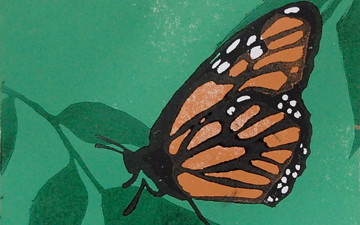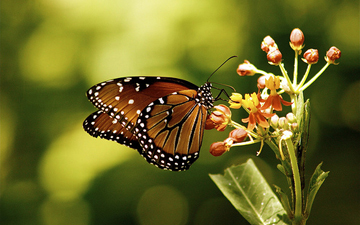The Monarch butterfly (Danaus plexippus) is a milkweed butterfly (subfamily Danainae), in the family Nymphalidae. It is perhaps the best known of all North American butterflies. Since the 19th century, it has been found in New Zealand, and in Australia since 1871 where it is called the Wanderer.[3][4][5] In Europe it is resident in the Canary Islands, the Azores, and Madeira, and is found as an occasional migrant in Western Europe. Its wings feature an easily recognizable orange and black pattern, with a wingspan of 8.9–10.2 centimetres (3½–4 in).[6] (The Viceroy butterfly has a similar size, color, and pattern, but can be distinguished by an extra black stripe across the hind wing.) Female Monarchs have darker veins on their wings, and the males have a spot called the “androconium” in the center of each hind wing[7] from which pheromones are released. Males are also slightly larger.
The Monarch is famous for its southward migration and northward return in summer in the Americas which spans the life of three to four generations of the butterfly.
(From Wikipedia, June 3rd, 2010)
– – –
The monarch is one of the best known butterfly species. Although native to North and South America, it has expanded its distribution to Australia, many Pacific islands, and a few places in Europe. Monarch larvae, like those of many other Danaini, feed on milkweeds of the family Asclepiadaceae, from which they sequester cardiac glycosides that often render them unpalatable to potential predators. The species is perhaps best known for its annual migrations, from eastern North America to the mountains of central Mexico, and from western North America to the coast of California. The butterflies rest for the cool winter months in large aggregations which may contain tens of millions of individuals.
(From Tree of Life via Encyclopedia of Life)
– – –





